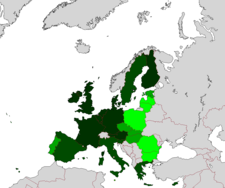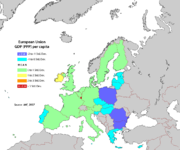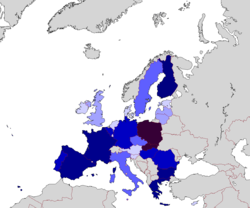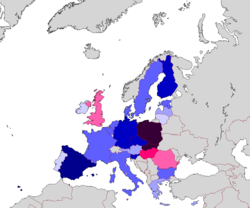Economy of the European Union
2008/9 Schools Wikipedia Selection. Related subjects: Economics
| Economy of the European Union | |
|---|---|
| Currency | 1 Euro (€) = 100 cents |
|
Other currencies in member states |
|
| Statistics | |
| GDP ranking | 1st (2006) |
| GDP ( PPP) | US $13.06 trillion (2006) |
| GDP growth rate | 3.1% (2006) |
| GDP per capita | US $29,900 (2006) |
| GDP by sector (2006) | 70.5% services 27.3% industry 2.1% agriculture |
| Inflation | 1.9% (2007) |
| Population below poverty threshold | 17% |
| Labour force | 221.5 million |
| Labour force by occupation (2006) | 67.0% services 27.3% industry 4.4% agriculture |
| Unemployment | 7.0% (May 2007) |
| Sources: | |
| Trading partners | |
| Imports | US $1.466 trillion (2006) |
|
Main import partners (2005) |
|
| Exports | US $1.33 trillion (ranking: 1st) (2006) |
|
Main export partners (2005) |
|
| Public finances | |
| Public debt | € 7,240.8 billion (58.7% of GDP) (2007) |
| Public deficit | € 109.5 billion (-0.9% of GDP) (2007) |
| Expenditure | € 5,648.6 billion (2007) |
| Revenue | € 5,537.6 billion (2007) |
| Note: The data in this section is derived from the combined public finance figures of each of the 27 EU member states Sources: Eurostat Data 2008 |
|
If it were considered as a single state, the economy of the European Union's twenty-seven member states would be the world's largest national economy. The EU accounts for 30.3% of the world's total GDP in 2005 ( World Bank figures).
Currency
The official currency of the European Union is the euro, used in all its documents and policies. The Stability and Growth Pact sets out the fiscal criteria to maintain for stability and (economic) convergence. The euro is also the most widely used currency in the EU, which is in use in 15 member states known as the Eurozone. All other member states, apart from Denmark and the United Kingdom which have special opt-outs, have committed to changing over to the Euro once they have fulfilled the requirements needed to do so - although Sweden also has an effective opt-out by choosing when or whether to join the European Exchange Rate Mechanism which is the preliminary step towards joining. The remaining states are committed to join the Euro through their Treaties of Accession.
Economic variation
Below is a table showing, respectively, the GDP ( PPP) and the GDP (PPP) per capita for the European Union and for each of its 27 member states, sorted by GDP (PPP) per capita. This can be used as a rough gauge to the relative standards of living among member states, with Luxembourg and Ireland the highest; Romania and Bulgaria the lowest. Eurostat, based in Luxembourg, is the Official Statistical Office of the European Communities releasing yearly GDP figures for the member states as well as the EU as a whole, which are regularly updated, supporting this way a measure of wealth and a base for the European Union's budgetary and economic policies. Figures are stated in euro. All data for 2007 are projections.
These are the official Eurostat figures, as of 21 April 2007.
| Member States | GDP (PPP) 2007 millions of euro |
GDP (PPP) per capita 2007 euro |
Percentage of EU27 average GDP (PPP) per capita |
||||
|---|---|---|---|---|---|---|---|
| 12,172,536 | 24,600 | 100% | |||||
| 1 |
2,340,372 | 28,200 | 115% | ||||
| 2 |
1,847,105 | 29,400 | 120% | ||||
| 3 |
1,744,444 | 27,800 | 113% | ||||
| 4 |
1,500,475 | 25,500 | 104% | ||||
| 5 |
1,121,961 | 25,400 | 103% | ||||
| 6 |
530,564 | 32,800 | 133% | ||||
| 7 |
525,277 | 15,143 | 55% | ||||
| 8 |
319,867 | 30,200 | 123% | ||||
| 9 |
274,499 | 30,000 | 122% | ||||
| 10 |
264,472 | 31,900 | 130% | ||||
| 11 |
246,671 | 22,100 | 90% | ||||
| 12 |
208,220 | 9,700 | 39% | ||||
| 13 |
207,174 | 20,100 | 82% | ||||
| 14 |
190,882 | 18,200 | 74% | ||||
| 15 |
171,298 | 31,200 | 127% | ||||
| 16 |
166,031 | 16,200 | 66% | ||||
| 17 |
157,070 | 35,700 | 147% | ||||
| 18 |
153,595 | 28,900 | 117% | ||||
| 19 |
88,602 | 16,400 | 67% | ||||
| 20 |
86,500 | 10,844 | 41% | ||||
| 21 |
50,241 | 15,000 | 61% | ||||
| 22 |
44,040 | 21,800 | 89% | ||||
| 23 |
33,630 | 14,900 | 61% | ||||
| 24 |
31,376 | 69,900 | 284% | ||||
| 25 |
23,919 | 17,900 | 73% | ||||
| 26 |
17,773 | 22,900 | 93% | ||||
| 27 |
7,824 | 18,600 | 76% | ||||
| Candidate countries: (not included in the EU total above) | |||||||
| 57,948 | 14,153 | 57% | |||||
| 541,418 | 7,300 | 30% | |||||
| 13,897 | 6,900 | 28% | |||||
Source:GDP(PPP): EUROSTAT
PERCENTAGES: EUROSTAT( ). Recalculated manually to EU27.
Economies of member states
Economic performance varies from state to state. The Growth and Stability Pact governs fiscal policy with the European Union. It applies to all member states, with specific rules which apply to the eurozone members that stipulate that each state's deficit must not exceed 3% of GDP and its public debt must not exceed 60% of GDP. However, many larger members have consistently run deficits substantially in excess of 3%, and the eurozone as a whole has a debt percentage exceeding 60% (see below).
With the exception of Greece and Portugal, all countries with below average GNI per capita are those which joined the EU in May 2004 and all countries with above average GNI per capita come from the existing (pre-2004) member states.
The following table shows information relating to the member states of the European Union, ordered according to the 'Size' of their economies. (NB: Were the table ordered according to 'GDP per capita' this would perhaps better reflect the strength of an individual economy. But this is not how such tables are commonly structured).
The colours denote how a member state is performing relative to the rest of the European Union, above average (green) or below average (red). The smallest and greatest values in each column are emphasised. The 2007 data are IMF estimates made in April 2007.
| Member State sorted by GDP |
GDP in billions of US $ (2007) |
GDP % of EU (2007) |
Annual change % of GDP |
GDP per capita in PPP US $ (2007) |
Public Debt % of GDP (2006) |
Deficit % of GDP (2006) |
Inflation % Annual (2007) |
Unemp. % (2006) |
|---|---|---|---|---|---|---|---|---|
| 15,183.4 | 100.0% | 2.8 | 29 342 | 63.8 | -2.6 | 2.2 | 7.5 | |
| 3,080.6 | 19.4% | 1.8 | 32,179 | 66.0 | -3.7 | 2.0 | 7.8 | |
| 2,660.7 | 16.8% | 2.9 | 36,568 | 41.6 | -3.2 | 2.3 | 5.3 | |
| 2,401.4 | 15.2% | 2.0 | 31,873 | 65.6 | -3.7 | 1.7 | 8.3 | |
| 1,993.7 | 12.6% | 1.8 | 31,694 | 105.8 | -3.0 | 2.1 | 6.8 | |
| 1,359.1 | 8.6% | 3.8 | 28,445 | 48.9 | -0.3 | 2.6 | 7.8 | |
| 720.9 | 4.5% | 2.9 | 36,240 | 55.7 | -2.5 | 1.8 | 3.2 | |
| 423.6 | 2.7% | 3.3 | 35,729 | 51.2 | -1.4 | 1.8 | 5.5 | |
| 423.5 | 2.7% | 2.2 | 35,693 | 95.6 | -0.1 | 1.9 | 7.8 | |
| 364.8 | 2.3% | 5.8 | 15,894 | 43.6 | -3.0 | 2.2 | 10.5 | |
| 348.7 | 2.2% | 2.8 | 37,536 | 65.2 | -1.3 | 1.6 | 4.5 | |
| 341.8 | 2.2% | 3.8 | 27,360 | 106.5 | -2.8 | 3.2 | 8.3 | |
| 302.6 | 1.9% | 2.5 | 38,072 | 42.7 | -2.8 | 2.0 | 4.7 | |
| 250.2 | 1.6% | 5.0 | 46,786 | 29.9 | -1.3 | 2.4 | 4.5 | |
| 225.4 | 1.4% | 3.1 | 36,324 | 43.6 | -2.1 | 1.5 | 7.5 | |
| 211.7 | 1.3% | 1.8 | 23,464 | 61.9 | -2.9 | 2.5 | 7.4 | |
| 160.4 | 1.0% | 4.8 | 24,679 | 37.4 | -3.0 | 2.9 | 6.6 | |
| 157.6 | 1.0% | 6.5 | 10,661 | 21.2 | -4.0 | 4.5 | 4.5 | |
| 125.0 | 1.0% | 2.8 | 20,700 | 57.6 | -4.5 | 6.4 | 7.9 | |
| 69.3 | 0.8% | 8.2 | 19,172 | 36.9 | -2.9 | 2.4 | 10.8 | |
| 45.8 | 0.3% | 4.6 | 84,507 | 7.5 | -1.1 | 2.1 | 4.6 | |
| 41.1 | 0.3% | 4.5 | 25,266 | 29.4 | -1.9 | 2.7 | 6.4 | |
| 35.8 | 0.2% | 6.0 | 10,677 | 24.8 | -4.0 | 5.3 | 7.8 | |
| 35.4 | 0.2% | 7.0 | 16,863 | 19.7 | -2.5 | 3.5 | 6.1 | |
| 24.1 | 0.2% | 10.5 | 17,364 | 14.4 | -0.8 | 7.3 | 6.3 | |
| 19.9 | 0.1% | 3.9 | 31,053 | 62.3 | -3.5 | 2.1 | 4.8 | |
| 19.6 | 0.2% | 9.9 | 20,114 | 4.9 | -1.8 | 4.8 | 4.2 | |
| 6.2 | 0.1% | 2.3 | 21,061 | 75.0 | -5.2 | 2.4 | 6.8 |
Economic growth
The EU's share of Gross world product (GWP) is stable at around one fifth . GDP growth, though strong in the new member states, is being affected by sluggish growth in France, Italy and Portugal.
Estonia and Latvia, also referred to as the Baltic Tigers, have the highest GDP growth rates in the union and one of the highest in the world.
| EU15 GDP growth rates | New member GDP growth rates | ||||||||||||||||||||||||||||||||||||||||||||||||||||||||||||||||||||||||||||||||||||||||||||||||||||||||||||||||||||||||||||||||||||||||||||||||||||||||||||||||||||||||
|
|
||||||||||||||||||||||||||||||||||||||||||||||||||||||||||||||||||||||||||||||||||||||||||||||||||||||||||||||||||||||||||||||||||||||||||||||||||||||||||||||||||||||||
The ten new member states of Eastern and North Europe have enjoyed a higher average percentage growth rate than their Western European counterparts. Notably the Baltic states have achieved massive GDP growth, with Latvia topping 11%, close to China, the world leader at 9% on average for the past 25 years. Reasons for this massive growth include government commitments to stable monetary policy, export-oriented trade policies, low flat-tax rates and the utilisation of relatively cheap labour.
The current map of EU growth is one of huge regional variation, with the larger economies suffering from stagnant growth and the new nations enjoying sustained, robust economic growth.
Although EU27 GDP is on the increase, the percentage of Gross world product is decreasing due to the emergence of economic powers such as China, India and Brazil. In the medium to long term, the EU will be looking to increase GDP growth in the central European economies such as France, Germany and Italy and stabilise growth in the new Eastern European states to ensure sustained economic prosperity.
Trade
The European Union is the largest exporter in the world ( ) and the second largest importer. Internal trade between the member states is aided by the removal of barriers to trade such as tariffs and border controls. In the eurozone, trade is helped by not having any currency differences to deal with amongst most members. The European Union Association Agreement does something similar for a much larger range of countries, partly as a so-called soft approach ('a carrot instead of a stick') to influence the politics in those countries.
The European Union represents all its members at the World Trade Organization, and acts on behalf of member states in any disputes.
Unemployment
The seasonally adjusted unemployment rate in the European Union in June 2007 was 6.9% compared to 7.9% in all current 27 memberstates in June 2006. The rate varies widely by member state. In comparison the United States had an unemployment rate of 4.5% and Japan a rate of 3.8% measured by Eurostat.
The following table states the current unemployment rate of all Member States for June 2007 with comparisons to June 2006:
|
|
||||||||||||||||||||||||||||||||||||||||||||||||||||||||||||||||||||||||||||||||||||||||||||||
Industries
The services sector is by far the most important sector in the European Union, making up 69.4% of GDP, compared to the manufacturing industry with 28.4% of GDP and agriculture with only 2.3% of GDP.
Agriculture
The agricultural sector is supported by subsidies from the European Union in the form of the Common Agricultural Policy (CAP). This currently represents 40-50% of the EU's total spending. It guarantees a minimum price for farmers in the EU. This is criticised as a form of protectionism, inhibiting trade, and damaging developing countries; one of the most vocal opponents is the UK, the second largest economy within the bloc, which has repeatedly refused to give up the annual UK Rebate unless the CAP undergoes significant reform; France, the biggest benefactor of the CAP and the bloc's third largest economy, is its most vocal proponent.
Tourism
The European Union is a major tourist destination, attracting visitors from outside of the Union and citizens travelling inside it. Internal tourism is made more convenient for the citizens of some EU member states by the Schengen treaty and the Euro. All citizens of the European Union are entitled to travel to any member state without the need of a visa. If the EU component states are considered separate entities, France is the world's number one tourist destination for international visitors, followed by Spain, Italy and the United Kingdom at 2nd, 5th and 6th spots respectively. If the EU is considered a single entity, the number of international visitors is less, as most visitors to EU nations are from other EU member states.
Companies
The European Union's member states are the birthplace of many of the world's largest leading multinational companies, and home to its global headquarters. Among these are distinguished companies ranked first in the world within their industry/sector, like Allianz, which is the largest financial service provider in the world by revenue; Airbus, which produces around half of the world's jet airliners; Air France-KLM, which is the largest airline company in the world in terms of total operating revenues; Amorim, which is the world's largest cork-processing and cork producer company; ArcelorMittal, which is the largest steel company in the world; Groupe Danone, which has the world leadership in the dairy products market; InBev, which is the largest beer company in the world; L'Oréal Group, which is the world's largest cosmetics and beauty company; LVMH, which is the world's largest luxury goods conglomerate; Nokia Corporation, which is the world's largest manufacturer of mobile telephones; Royal Dutch Shell, which is the largest energy corporation in the world; and Stora Enso, which is the world's largest pulp and paper manufacturer in terms of production capacity. Many other European companies rank among the world's largest companies in terms of turnover, profit, market share, number of employees or other major indicators. A considerable number of EU-based companies are ranked among the worlds' top-ten within their sector of activity.
Regional variation
Comparing the richest areas of the EU can be a difficult task. This is because the NUTS 1 & 2 regions are not homogenous, some of them being very large regions, such as NUTS-1 Hesse (21,100 km²) or NUTS-1 Île-de-France (12,011 km²), whilst other NUTS regions are much smaller, for example NUTS-1 Hamburg (755 km²) or NUTS-1 Greater London (1,580 km²). An extreme example is Finland, which is divided for historical reasons into mainland Finland with 5.3 million inhabitants and Åland, an island with a population of 26,700, or about the population of a small Finnish city.
One problem with this data is that in some areas, including Greater London, are subject to a large number of commuters coming into the area, thereby artificially inflating the figures. It has the effect of raising GDP but not altering the number of people living in the area, inflating the GDP per capita figure. Similar problems can be produced by a large number of tourists visiting the area.
The data is used to define regions that are supported with financial aid in programs such as the European Regional Development Fund.
The decision to delineate a Nomenclature of Territorial Units for Statistics (NUTS) region is to a large extent arbitrary (i.e. not based on objective and uniform criteria across Europe), and is decided at European level (See also: Regions of the European Union).
Top 10: economically strongest NUTS-1 and NUTS-2 regions
The 10 NUTS-1 and NUTS-2 regions with the highest GDP per capita are all in the first fifteen member states: none are in the 12 new member states that joined in May 2004 and January 2007. The NUTS Regulation lays down a minimum population size of 3 million and a maximum size of 7 million for the average NUTS-1 region, whereas a minimum of 800.000 and a maximum of 3 million for NUTS-2 regions ¹ . This definition, however, is not respected by Eurostat. E.g.: the région of Île-de-France, with 11.6 million inhabitants, is treated as a NUTS-2 region, while the state of Bremen, with only 664,000 inhabitants, is treated as a NUTS-1 region.
| Rank | NUTS-1 region | 2004 GDP (PPP) per capita in Euros |
|---|---|---|
| 1 |
Luxembourg | 53,978 |
| 2 |
Brussels-Capital, Belgium | 53,381 |
| 3 |
Hamburg, Germany | 41,972 |
| 4 |
Greater London, United Kingdom | 40,542 |
| 5 |
Île-de-France, France | 37,526 |
| 6 |
Bremen, Germany | 33,508 |
| 7 |
Åland, Finland | 31,909 |
| 8 |
Randstad, Netherlands | 30,762 |
| 9 |
Ireland | 30,414 |
| 10 |
Bavaria, Germany | 29,646 |
| Rank | NUTS-2 region | 2004 GDP (PPP) per capita in Euros |
|---|---|---|
| Note that are treated as NUTS-3 by Eurostat and are thus not listed here. |
||
| 1 |
Inner London, United Kingdom | 65,138 |
| 2 |
Luxembourg | 53,978 |
| 3 |
Brussels-Capital, Belgium | 53,381 |
| 4 |
Hamburg, Germany | 41,972 |
| 5 |
Vienna, Austria | 38,632 |
| 6 |
Île-de-France, France | 37,526 |
| 7 |
Berkshire, Buckinghamshire & Oxfordshire, United Kingdom | 37,379 |
| 8 |
Oberbayern ( Upper Bavaria), Germany | 36,408 |
| 9 |
Stockholm, Sweden | 35,621 |
| 10 |
Utrecht, Netherlands | 33,905 |
Economically weakest NUTS-2 regions
The fifteen lowest regions in the ranking in 2004 were all in Bulgaria, Poland and Romania, with the lowest figures recorded in Nord-Est in Romania (24% of the average), followed by Severozapaden, Yuzhen tsentralen and Severen tsentralen in Bulgaria (all 26%). Among the 70 regions below the 75% level, fifteen were in Poland, eight each in Greece and Romania, seven in the Czech Republic, six each in Bulgaria and Hungary, four each in France (all overseas departments), Italy and Portugal, three in Slovakia, one region in Spain, and Estonia, Latvia, Lithuania and Malta.
| Rank | NUTS-2 region | 2004 GDP (PPP) per capita in Euros |
% of the average GDP of EU27 in 2004 |
|---|---|---|---|
| 1 |
Nord-Est, Romania | 5,070 | 24 |
| 2 |
Severozapaden, Bulgaria | 5,502 | 26 |
| 3 |
Yuzhen tsentralen, Bulgaria | 5,509 | 26 |
| 4 |
Severen tsentralen, Bulgaria | 5,681 | 26 |
| 5 |
Sud, Romania | 6,111 | 28 |
| 6 |
Sud-Vest, Romania | 6,183 | 29 |
| 7 |
Severoiztochen, Bulgaria | 6,299 | 29 |
| 8 |
Yugoiztochen, Bulgaria | 6,420 | 30 |
| 9 |
Sud-Est, Romania | 6,612 | 31 |
| 10 |
Nord-Vest, Romania | 7,093 | 33 |
| 11 |
Lubelskie, Poland | 7 568 | 35 |
| 12 |
Podkarpackie, Poland | 7 617 | 35 |
| 13 |
Centru, Romania | 7 629 | 35 |
| 14 |
Podlaskie, Poland | 8 148 | 38 |
| 15 |
Vest, Romania | 8 395 | 39 |
Richest & Poorest NUTS-2 Regions (GDP PPP 2004)
See also: List of all NUTS-2 regions with GDP 2004 data
| Member State | Region | GDP per capita | |
|---|---|---|---|
| in Euros | As % of EU-27 average | ||
| 21,503 | 100.0% | ||
| 27,666 | 128.7% | ||
| Richest | Vienna | 38,632 | 179.7% |
| Poorest | Burgenland | 19,305 | 89.8% |
| 26,759 | 124.4% | ||
| Richest | Brussels-Capital | 53,381 | 248.3% |
| Poorest | Hainaut | 17,546 | 81.6% |
| 7,134 | 33.2% | ||
| Richest | Yugozapaden | 10,550 | 49.1% |
| Poorest | Severozapaden | 5,502 | 25.6% |
| 19,648 | 91.4% | ||
| 16,171 | 75,2% | ||
| Richest | Prague | 33,784 | 157.1% |
| Poorest | Central Moravia | 12,856 | 59.8% |
| 26,772 | 124.5% | ||
| 24,146 | 112.3% | ||
| Richest | Ile-de-France | 37,526 | 174.5% |
| Poorest | French Guiana | 11,690 | 54.4% |
| 24,903 | 115.8% | ||
| Richest | Hamburg | 41,972 | 195.2% |
| Poorest | Dessau | 16,295 | 75.8% |
| 11,978 | 55.7% | ||
| 24,834 | 115.5% | ||
| Richest | Åland | 31,461 | 146.3% |
| Poorest | East Finland | 18,336 | 85.3% |
| 18,245 | 84.8% | ||
| Richest | Athens | 24,230 | 112.7% |
| Poorest | West Greece | 11,714 | 54.5% |
| 13,751 | 64.0% | ||
| Richest | Central Hungary | 21,837 | 101.6% |
| Poorest | Northern Hungary | 9,003 | 41.9% |
| 30,414 | 141.4% | ||
| Richest | Southern and Eastern | 33,653 | 156.5% |
| Poorest | Border, Midland and Western | 21,518 | 100.1% |
| 23,095 | 107.4% | ||
| Richest | Lombardy | 30,426 | 141.5% |
| Poorest | Sicily | 14,447 | 67.3% |
| 9,775 | 45.5% | ||
| 10,981 | 51.1% | ||
| 53,978 | 251.0% | ||
| 15,988 | 74.4% | ||
| 27,946 | 130.0% | ||
| Richest | Utrecht | 33,905 | 157.7% |
| Poorest | Flevoland | 20,736 | 96.4% |
| 10,908 | 50.7% | ||
| Richest | Mazowieckie | 16,523 | 76.8% |
| Poorest | Lubelskie | 7,568 | 35.2% |
| 16,086 | 74.8% | ||
| Richest | Lisbon | 22,745 | 105.8% |
| Poorest | Norte | 12,648 | 58.8% |
| 7,301 | 34.0% | ||
| Richest | Bucharest-Ilfov | 13,862 | 64.5% |
| Poorest | North East Romania | 5,070 | 23.6% |
| 12,196 | 56.7% | ||
| Richest | Bratislava region | 27,802 | 129.3% |
| Poorest | Prešovský kraj & Košický kraj | 9,102 | 42.3% |
| 17,920 | 83.3% | ||
| 21,658 | 100.7% | ||
| Richest | Madrid | 28,416 | 132.1% |
| Poorest | Extremadura | 14,419 | 67.1% |
| 25,865 | 120.3% | ||
| Richest | Stockholm | 35,621 | 165.7% |
| Poorest | East Middle Sweden | 21,862 | 101.7% |
| 26,455 | 123.0% | ||
| Richest | Inner London | 65,138 | 302.9% |
| Poorest | Cornwall & Isles of Scilly | 17,025 | 79.2% |
Comparison with regional blocs
| Regional bloc1 | Area | Population | GDP ($US) | Member states1 |
||||
|---|---|---|---|---|---|---|---|---|
| km² | sq mi | in millions (PPP) | in millions (nominal) | per capita (PPP) | per capita (nominal) | |||
| AU | 29,797,500 | 11,504,879 | 897,548,804 | 1,515,000 | 1,131,850 | 1,896 | 1,261 | 53 |
| ASEAN (2007 est.) | 4,497,493 | 1,736,000 | 566,500,000 | 3,115,480 | 1,173,000 | 5,541 | 2,041 | 10 |
| CACM | 422,614 | 163,172 | 37,816,598 | 159,536 | 84,792 | 4,219 | 2,242 | 5 |
| CARICOM | 462,344 | 178,512 | 14,565,083 | 64,219 | 24,020 | 4,409 | 1,649 | (14+1)3 |
| CCASG / GCC | 2,285,844 | 882,569 | 35,869,438 | 536,223 | 717,800 | 14,949 | 20,011 | 6 |
| CEFTA | 298,148 | 115,116 | 28,929,682 | 222,041 | 122,001 | 7,675 | 4,217 | (7+1)3 |
| EU (2007 est.) | 4,324,782 | 1,669,808 | 497,000,000 | 14,953,000 | 16,574,000 | 28,213 | 33,482 | 27 |
| EurAsEC | 20,789,100 | 8,026,720 | 208,067,618 | 1,689,137 | 1,125,528 | 8,118 | 5,409 | 6 |
| EFTA (2007 est.) | 529,600 | 204,480 | 12,660,623 | 567,500 | 743,300 | 44,828 | 60,000 | 4 |
| GAFTA | 9,421,946 | 3,637,834 | 280,727,416 | 1,341,298 | N/A | 4,778 | N/A | (16+1)3 |
| GUAM | 810,506 | 312,938 | 63,764,600 | 456,173 | 106,469 | 7,154 | 1,670 | 4 |
| NAFTA (2007 est.) | 21,783,850 | 8,410,792 | 445,000,000 | 15,857,000 | 15,723,000 | 35,491 | 35,564 | 3 |
| PARTA | 528,151 | 203,920 | 7,810,905 | 23,074 | N/A | 2,954 | N/A | (12+2)3 |
| SAARC | 5,136,740 | 1,983,306 | 1,467,255,669 | 4,074,031 | N/A | 2,777 | N/A | 8 |
| Unasur / Unasul | 17,339,153 | 6,694,684 | 370,158,470 | 2,868,430 | N/A | 7,749 | N/A | 12 |
| UN and countries for reference2 |
Area | Population | GDP ($US) | Units4 | ||||
| km² | sq mi | in millions (PPP) | in millions (nominal) | per capita (PPP) | per capita (nominal) | |||
| UN | 133,178,011 | 51,420,318 | 6,411,682,270 | 55,167,630 | 48,245,198 | 8,604 | 7,524 | 192 |
| Brazil (2007 est.) | 8,514,877 | 3,287,612 | 183,888,841 | 1,804,000 | 1,067,706 | 10,073 | 6,842 | 27 |
| Canada (2007 est.) | 9,984,670 | 3,855,103 | 33,000,000 | 1,274,000 | 1,406,000 | 38,200 | 42,738 | 13 |
| India (2007 est.) | 3,287,590 | 1,269,346 | 1,120,000,000 | 4,726,000 | 1,089,000 | 4,182 | 1,004 | 35 |
| Japan (2007 est.) | 377,873 | 145,898 | 127,433,494 | 4,346,000 | 4,346,000 | 33,800 | 38,341 | 47 |
| PR China5 (2007 est.) | 9,596,960 | 3,705,407 | 1,321,851,888 | 7,043,000 | 3,420,000 | 5,300 | 2,800 | 33 |
| Russia (2007 est.) | 17,075,200 | 6,592,772 | 142,500,000 | 2,076,000 | 1,286,000 | 14,600 | 9,056 | 83 |
| USA (2007 est.) | 9,826,630 | 3,794,083 | 302,000,000 | 13,543,000 | 13,794,700 | 43,500 | 45,594 | 50 |
|
smallest value among the blocs compared largest value among the blocs compared
Footnotes |
||||||||




